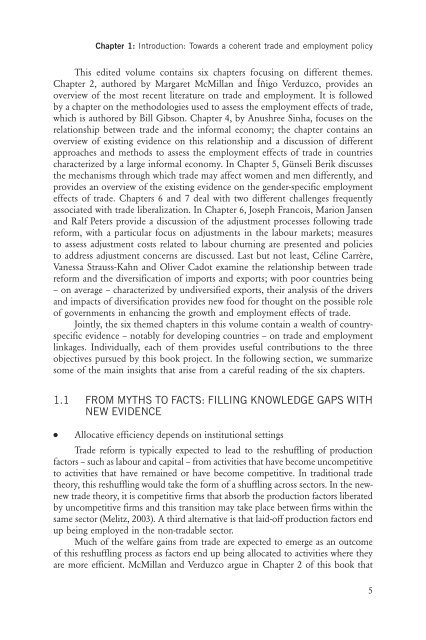Trade and Employment From Myths to Facts - International Labour ...
Trade and Employment From Myths to Facts - International Labour ...
Trade and Employment From Myths to Facts - International Labour ...
Create successful ePaper yourself
Turn your PDF publications into a flip-book with our unique Google optimized e-Paper software.
Chapter 1: Introduction: Towards a coherent trade <strong>and</strong> employment policy<br />
This edited volume contains six chapters focusing on different themes.<br />
Chapter 2, authored by Margaret McMillan <strong>and</strong> Íñigo Verduzco, provides an<br />
overview of the most recent literature on trade <strong>and</strong> employment. It is followed<br />
by a chapter on the methodologies used <strong>to</strong> assess the employment effects of trade,<br />
which is authored by Bill Gibson. Chapter 4, by Anushree Sinha, focuses on the<br />
relationship between trade <strong>and</strong> the informal economy; the chapter contains an<br />
overview of existing evidence on this relationship <strong>and</strong> a discussion of different<br />
approaches <strong>and</strong> methods <strong>to</strong> assess the employment effects of trade in countries<br />
characterized by a large informal economy. In Chapter 5, Günseli Berik discusses<br />
the mechanisms through which trade may affect women <strong>and</strong> men differently, <strong>and</strong><br />
provides an overview of the existing evidence on the gender-specific employment<br />
effects of trade. Chapters 6 <strong>and</strong> 7 deal with two different challenges frequently<br />
associated with trade liberalization. In Chapter 6, Joseph Francois, Marion Jansen<br />
<strong>and</strong> Ralf Peters provide a discussion of the adjustment processes following trade<br />
reform, with a particular focus on adjustments in the labour markets; measures<br />
<strong>to</strong> assess adjustment costs related <strong>to</strong> labour churning are presented <strong>and</strong> policies<br />
<strong>to</strong> address adjustment concerns are discussed. Last but not least, Céline Carrère,<br />
Vanessa Strauss-Kahn <strong>and</strong> Oliver Cadot examine the relationship between trade<br />
reform <strong>and</strong> the diversification of imports <strong>and</strong> exports; with poor countries being<br />
– on average – characterized by undiversified exports, their analysis of the drivers<br />
<strong>and</strong> impacts of diversification provides new food for thought on the possible role<br />
of governments in enhancing the growth <strong>and</strong> employment effects of trade.<br />
Jointly, the six themed chapters in this volume contain a wealth of countryspecific<br />
evidence – notably for developing countries – on trade <strong>and</strong> employment<br />
linkages. Individually, each of them provides useful contributions <strong>to</strong> the three<br />
objectives pursued by this book project. In the following section, we summarize<br />
some of the main insights that arise from a careful reading of the six chapters.<br />
1.1 FROM MYTHS TO FACTS: FILLING KNOWLEDGE GAPS WITH<br />
NEW EVIDENCE<br />
● Allocative efficiency depends on institutional settings<br />
<strong>Trade</strong> reform is typically expected <strong>to</strong> lead <strong>to</strong> the reshuffling of production<br />
fac<strong>to</strong>rs – such as labour <strong>and</strong> capital – from activities that have become uncompetitive<br />
<strong>to</strong> activities that have remained or have become competitive. In traditional trade<br />
theory, this reshuffling would take the form of a shuffling across sec<strong>to</strong>rs. In the newnew<br />
trade theory, it is competitive firms that absorb the production fac<strong>to</strong>rs liberated<br />
by uncompetitive firms <strong>and</strong> this transition may take place between firms within the<br />
same sec<strong>to</strong>r (Melitz, 2003). A third alternative is that laid-off production fac<strong>to</strong>rs end<br />
up being employed in the non-tradable sec<strong>to</strong>r.<br />
Much of the welfare gains from trade are expected <strong>to</strong> emerge as an outcome<br />
of this reshuffling process as fac<strong>to</strong>rs end up being allocated <strong>to</strong> activities where they<br />
are more efficient. McMillan <strong>and</strong> Verduzco argue in Chapter 2 of this book that<br />
5

















